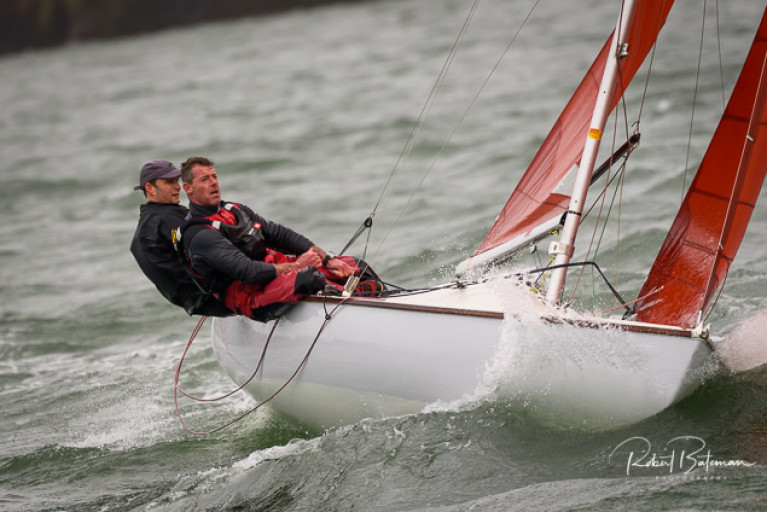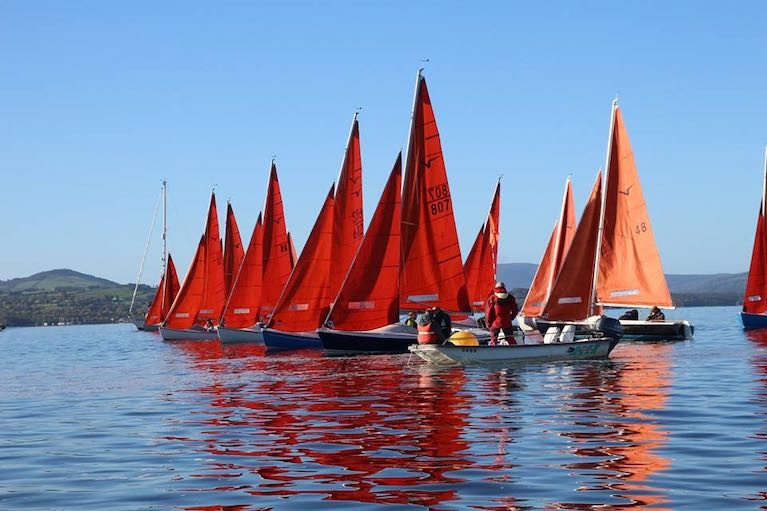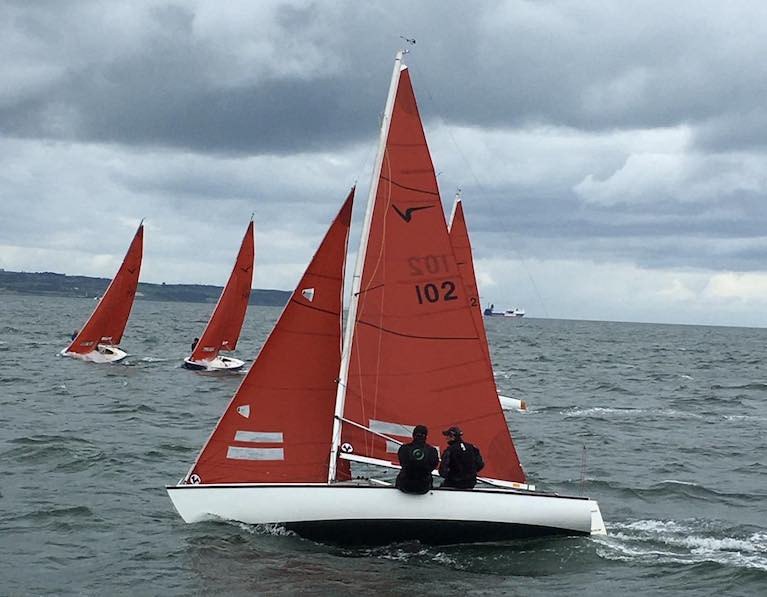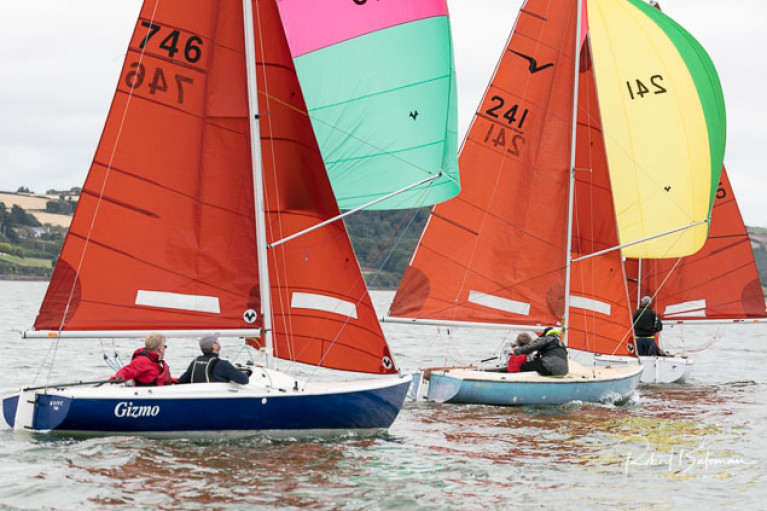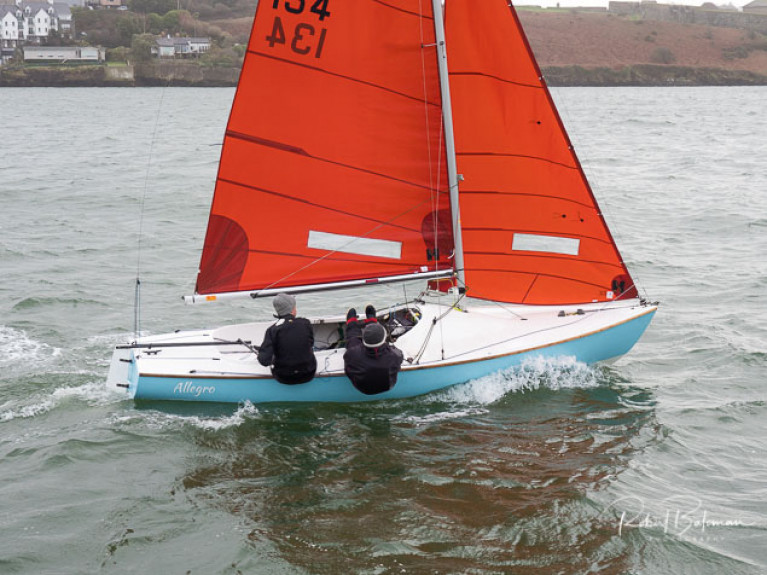Displaying items by tag: squib
With sailing slowly re-emerging in Ireland which is still some distance from being post-pandemic, we seem to be seeing our sport taking shape again with a series of baby steps.
In such circumstances, there’s much to be said for the purchase of a race-ready and versatile boat that only needs to be rigged to provide immediate activity at one of the country’s several Squib sailing centres.
And this well-maintained version of the Oliver Lee-designed 19ft classic keelboat fits the bill to perfection, as the details and specification make for fascinating racing for longtime Squib aficionados and newcomers alike.
 Close action for Squib keelboats - while they still carry the original 1967 rig with the distinctive tanned sails, today’s Squib class have greatly advanced their sail-trimming techniques
Close action for Squib keelboats - while they still carry the original 1967 rig with the distinctive tanned sails, today’s Squib class have greatly advanced their sail-trimming techniques
Newcomers will find it intriguing that a 1968 boat is still seen as a prime contender, but that’s the way it is with the Squibs. Having a brand new boat is by no means a guarantee of success, and dyed-in-the-wool Squib connoisseurs are well able to debate for hours which particular generation of Squibs produced the most successful boats.
Then too, apart from the sport of the racing and the class camaraderie that goes with it, the bonus with the Squib is that this really is a proper tittle yacht with a genuine sit-in cockpit, such that she’s a very practical proposition for simply taking the family out for a day sail.
See Squib 42 for sale here
Dun Laoghaire Harbour Squibs Donate To RNLI & Prepare to Race Against Mermaids in DBSC Summer Series
The Dun Laoghaire Harbour Squib fleet is making its plans for the 2021 season. Assuming that levels of Covid will drop sufficiently Dublin Bay Sailing Club have agreed to provide racing for a combined fleet of three-man wooden Mermaids and two-man GRP Squibs.
The Squibs give the Mermaids an allowance of one minute in the hour to make for fair racing.
The Dun Laoghaire Squib Fleet have reassessed their financial needs and realise they had enough money in their fleet bank account to buy a very good second-hand Squib.
Second-hand Squibs change hands for anything between €500 and €12,000 depending on manufacturer and condition.
 Squibs (above) will give the Mermaids (below) an allowance of one minute in the hour to make for fair racing in DBSC racing this Summer. Photos Bob Bateman
Squibs (above) will give the Mermaids (below) an allowance of one minute in the hour to make for fair racing in DBSC racing this Summer. Photos Bob Bateman

At an AGM held on Zoom last autumn, it was decided to make a substantial presentation to the Dun Laoghaire lifeboat.
The presentation of a cheque for €4,500 was made by Jill Fleming, Derek Jago and Gillian Fletcher on behalf of the Squib Fleet in late February 2021.
Dun Laoghaire Lifeboat was delighted to receive the presentation.
Vincent Delany
Dun Laoghaire Squib Captain
Squibs Keelboats Release 2021 Fixtures Race Calendar
The Irish Squib keelboat class will kick off its 2021 season at the Royal North of Ireland Yacht Club on Belfast Lough on May 29th, according to the provisional 2021 fixtures calendar released this week.
Next on the 2021 list is the Southern Championships at Kinsale Yacht Club in July. This is the venue for the class's 2022 Squib Combined Irish & UK Championships with an expected fleet of 75 or more Squibs, so the Southerns represents valuable practice time on the championship racecourse for the Irish fleet. Full 2021 fixtures are below.
Irish Squib Event Dates for 2021 (subject to Covid restrictions)
- Northerns RNIYC, May 29th & 30th
- Southerns Kinsale, July 17th & 18th
- Irish Nationals Killyleagh Yacht Club, August 6th, 7th & 8th
- Easterns September 4th & 5th Howth Yacht Club
- Inlands, October 16th & 17th October Lough Derg Yacht Club
Kinsale Yacht Club To Host 2022 Squib Combined Irish & UK Championships
At the recent Squib one-design keelboat class Irish AGM held on Zoom, it was confirmed that Kinsale Yacht Club will host the combined Irish and UK National Championships 19-24 June 2022 with an expected fleet of 75 or more Squibs.
A good number of members attended the AGM from the North, East and South coasts.
Robert Marshall of Killyleagh Yacht Club was unanimously elected Chairman of the Irish Squib Forum (the representative body for Squib Owners in Ireland north and south), Ian Travers of Kinsale Yacht Club was elected Vice-Chairman. Ronan MacDonnell of Howth Yacht Club was elected Hon. Treasurer and Fergus O'Kelly also of Howth Yacht Club was re-elected Technical Advisor.
Colm Dunne of Kinsale Y.C. was re-elected Irish Representative to the National Squib Owners Association in the United Kingdom.
 The 2021 Irish National Squib Championships will be held at Killyleagh from 6-8 August
The 2021 Irish National Squib Championships will be held at Killyleagh from 6-8 August
Subject to Covid 19 restrictions the proposed programme for 2021 is as follows:
- Irish National Championships in Killyleagh 6-8 August.
- NSOA championships in Abersoch (Wales) 27 June- 3 July.
- Northern Championships in Royal North Yacht Club in May.
- Eastern Championship in Howth Yacht Club in September.
- Southern Championship to be confirmed.
Squib Events for 2022
It was confirmed at the AGM that Kinsale Yacht Club will host the combined Irish and UK National Championships 19-24 June 2022 with an expected fleet of 75 or more Squibs.
Prodigal Crew Win Squib Battle at Royal North of Ireland Yacht Club
An Olympian, World and national champion were among the sailors competing at Royal North of Ireland Yacht Club for the 13-boat 2020 Squib Class Northern Championships on Belfast Lough.
Race 1, 17kts WNW, got away without a hitch, 13 boats on a tight line slipstream sailed by Neil Logan & Robert Marshall with the new Batt sails was showing great boatspeed and rounded the windward mark first, closely followed by Toy For The Boys, Peter Wallace and Martin Weatherstone and Aficionado, John Driscoll and Andrew Vaughan sailed in a dog fight around the course, there were some great waves to surf along on downwind that the fleet relished and it finished with Toy taking line honours from Aficionado, Slipstream 3rd with Prodigal 4th sailed by Greg Bell and Jane Kearney.
 1st place - Prodigal, Greg Bell and Jane Kearney
1st place - Prodigal, Greg Bell and Jane Kearney
Race 2, had a short postponement as the rain passed down the left side of the course which caused a wind shift, again it started in 17kts to 20kts WNW the fleet were hot out the start and with Toy For The Boys showing amazing boat speed with the new Hyde Jib on, they dominated from start to finish with Prodigal finishing 2nd and Aficionado 3rd.
Race 3, saw the breeze drop to about 12kts, Slipstream again showing the fleet a clean pair of heels followed by prodigal and Aficionado, Toy was involved in an infringement and had to do a 720 and hag to fight there way back, Fagin, Gordon Patterson and Ross Nolan after gear issues made a showing at the front of the fleet. The race finished. Slipstream 1st, Prodigal 2nd and Aficionado 3rd with Fagin 4th.
 2nd place - Toy for the boys, Peter Wallace and Martin Weatherstone
2nd place - Toy for the boys, Peter Wallace and Martin Weatherstone
Day 2
It was all to play for on Day two. Would Toy triumph, could Prodigal prevail or would Aficionado ascend to victory?
Race 4, started off in a WNW 5 to 6 knots, the first start was a general recall as the tide was pushing everyone over the start line. The second start got away well and there was an individual recall up and Prodigal went back to restart, the fleet split left and right and it was Toy to round the top mark first, followed by Jumani sailed by Ross Kearney and Charles Kearney, Then Fagin Patterson and Nolan. Down the run Toy found out they were OCS and pulled out of the race, the fight was on between Jumani, Fagin, Aficionado and Firecracker. Firecracker sailed by Steven Bridges and Matthew Bolton went hard right and Jumani worked there way up the course left of centre, Firecracker rounded ahead but there was drama to unfold, a rain cloud hit the fleet and the wind swung 180 degrees and turned the run into a beat, Firecracker maintained there lead to win a shortened finish followed by Aficionado, Fagin and Jumani.
 3rd place - Neil Logan and Robert Marshall
3rd place - Neil Logan and Robert Marshall
Race 5, didn't start till the rain had passed and the wind settled, the sky cleared and the wind was coming from a NE direction 5 to 6 kts, the race got away clean and Prodigal sailed by Greg Bell and Jane Kearney showed their intentions and were hot out the blocks followed by Jumani, Slipstream, Aficionado and Fagin, Toy didn't get a great start and had to work there way back up the fleet. The race win was taken by Slipstream, then Prodigal followed by Toy and Firecracker.
Race 6, started in a very light breeze 3 or 4kts from an ENE direction, the tide caused a few issues at the pin end of the start with a number of boats not making it and having to bail out, once again Prodigal was quick out the blocks with a clean start, followed by Fagin and Jumani, first round the top mark was Toy on a big left-hand lift followed by Outlaw, Ian Travers and Keith O'Riordan then Slipstream. The wind was very light and flicking, up the second beat there was a big right-hand lift which saw Second Chance sailed by Stephen Stewart and Kevin Thomas take full advantage rounding the windward mark first followed by Jumani and Prodigal with the race almost becoming a drifter the PRO shortened the course down the run and the race was won by Second Chance, then Jumani and Prodigal.
 Squib Northern Championships 2020 Results
Squib Northern Championships 2020 Results
Squib Irish Nationals 2020 Cancelled at Howth Yacht Club
The Irish Squib Class and Howth Yacht Club have made the difficult decision to cancel the Irish Squib Championships scheduled for this coming weekend, following the updated Government guidance issued on Tuesday.
In a statement, the class says "Whilst we are confident that racing could be held within the parameters of the Government and Public Health advice, it would not be possible to deliver the hoped-for on-shore activities in a socially responsible manner and in compliance with the updated restrictions announced yesterday. We would like to thank the team at Challenge.ie for its support in sponsoring this event and look forward to collaborating with them on events in future".
Kinsale overnight leader Colm Dunne at the helm of Allegro held off a strong Northern Ireland Challenge to win the Squib Southern Championships at Cove Sailing Club this afternoon.
As reported earlier, 13 boats contested the championships in Cork Harbour but no one was able to overhaul Dunne who counted three race wins on the windward-leeward courses.
Second place after five races sailed in the one-design keelboat competition went to Royal North of Ireland's Gordon Patterson. Third place went to Patterson's Belfast Lough club-mate Peter Wallace, skipper of Toy for the Boys.
Results are here
Bob Bateman's Day Two Photo Gallery below
The first major Class championships this season and the first in Cork Harbour will go ahead at Cove Sailing Club next weekend. The Squib Southerns will be based at the new Cove SC clubhouse and marina at Whitepoint.
The event and the marina are a big boost for the harbour town. Cobh has long-needed facilities for visiting boats. Several previous attempts to build a marina there failed. Cove Sailing Club, which celebrated its centenary last year, undertook its own project. It was not without difficulties and financial pressures which did create some internal club difficulties. At one stage another club, the Great Island Sailing Club, was formed and organised cruiser racing while remaining club members devoted their attention to getting the marina built. They succeeded, the new marina is now in operation, the clubs have re-united, with Great Island ceasing activities and members back in Cove Sailing Club which is a busy place at present.
 Race Officers get the first race away from Cove Island Sailing Club's new marina pontoons Photo: Bob Bateman
Race Officers get the first race away from Cove Island Sailing Club's new marina pontoons Photo: Bob Bateman
There is also a new clubhouse and dinghy sailing is resuming, with training courses also going ahead.
Kieran Dorgan is Cove Sailing Club’s Commodore and is my Podcast guest this week, discussing the developments and the economic boost which the marina will provide to the town of Cobh. I started by asking him about the Squibs Southern Championships next weekend, with racing on Saturday and Sunday, July 25 and 26:
Cove Sailing Club’S first evening league of the season was won by Commodore Dorgan’s Altair, a First 36.7 David Doyle’s Sigma 33, Musketeer, was second and Norman Allen’s Impala, Nadia, third. Twelve yachts raced.
What To Do When The Sailing Season Seems to Collapse?
One-by-one they came in this week – cancellations of planned events. The Royal Cork’s 300th celebrations. I commiserated with the club’s Admiral, Colin Morehead. A tough decision for him in his first few months in office. Cork Week had to be abandoned. The Squib National Championships at Kinsale which, when I wrote last week’s column were still going ahead, were also cancelled as were many other planned events.
One of my favourites, the Classics at Glandore Harbour Yacht Club in West Cork, which I’ve sailed in several times, are set for July 18-24 and were to connect with the RCYC’s 300th.
Commodore, Eamon Timoney has told club members that GHYC is still committed to the Classic 2020 schedule but, things may change: “Our strategy is to plan for our various events, including the Classic Regatta until such time as a cancellation or postponement is required. The Committee will endeavour to do this in a timely way.”
Another of the major events in which I take particular interest and raced three times - the Round Ireland Yacht Race - is still set for Saturday, June 20. Wicklow Sailing Club says it will “make a call on whether or not to go ahead with the race towards the end of April.”
This weekend, my own club the RCYC closed its entire site including access to the marinas until Easter Sunday, April 12.
So what to do when the planned sailing season seems to collapse? My plan had been for installing some new electronics on Scribbler, my Sigma 33. I was looking forward to that, all planned when the crisis hit. Now she sits amongst many other boats in the boatyard as the sailing fraternity waits to see what will happen.
Upwind & Downwind Sailing
So I’ve been turning my mind to thoughts of that beautiful moment at the start of each season when Scribbler lifts to the first wave after she’s been launched and wondering when I will feel that moment this year.
In this frame of mind, I’ve been considering upwind and downwind sailing.
When I took up the sport I was told that upwind is “toughest and worst” as the boat and crew beat a course to reach the windward mark. When the sea is bouncy it sure is not pleasant. As a novice learner I was told that the reward came with “freeing sails” and “setting the spinnaker.”
How then to account for my feeling of anxiety and concern that seems to encase my thoughts when that forward-bearing cloth goes up. I’ve sailed on various boats with different owners and listened to the shouts of “sheet; no get the guy; no I said sheet in; for pity’s sake let it out, it’s going to twist….” Those instructions are not always couched in pleasant terms and more brusque and blunt words have been used.
I’ve ”flown the spinnaker” on yachts of my own and on other people’s, on boats of various sizes; in the Round Ireland; across the Atlantic in the Whitbread Round the World Race. My family crew love “getting the spinnaker up,” with obvious delight and a feeling of fulfilment when it fills and Scribbler pulls away with the power of the crinkling upfront sail…
So, is my view of spinnakers because my early experiences of cruisers, contrasted from an owner whose view was “best left at home in the attic,” or the enthusiast for having his multi-coloured spinnaker flying when, as we cruised on a nice day off Schull, sun shining, the water nicely flat, happy with a sandwich and a glass of wine when he announced he wanted the spinnaker up and one of my crewmates replied: “Oh no, just when we were all getting along so nicely…..”
Listen to the PODCAST below
Kinsale Squib Nationals is Cancelled in June
The Squib National Championships 2020 scheduled for 21 - 26 June at Kinsale Yacht Club has been cancelled.
Regatta Director, Ruth Ennis told Afloat: 'The Squib 2020 Organising Committee in conjunction with Kinsale Yacht Club and the N.S.O.A. reluctantly made this decision in light of the COVID-19 pandemic'.
The prospect of the championships going ahead was discussed as recently as this week by Tom MacSweeney on Afloat here.
Ennis says Kinsale is looking at the 'possibility and logistics of hosting the event in Kinsale Yacht Club next year 2021'. All registration fees to the event will be refunded.


























